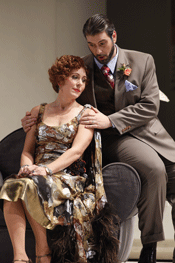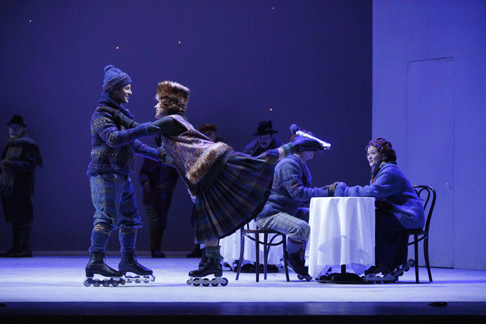I am not referring to the hectic happy marriage of
Richard and Pauline Strauss, the model on which Strauss constructed
Intermezzo, his portrait of the composer at home with the non-stop
assault of his termagant wife accusing and blaming and admitting she’d
find it dull to live with someone who didn’t fight back. I’m
referring to the supremely happy marriage of artist and role (which, like any
happy marriage, calls for luck and hard work) now on offer at the New York City
Opera, where Mary Dunleavy has taken on the shrewish coloratura flights and
turn-on-a-dime changes of mood that are Christine Storch.
Dunleavy’s honeyed voice resembles that of RenÈe Fleming before that
grande dame became so affected and spoiled. I first heard Dunleavy’s
sturdy lyric soprano as that roughest of dramatic coloratura workouts,
Konstanze in Mozart’s Seraglio, and a woman who can handle
Konstanze with credit can probably wrestle tigers. More recently she has been
an admired Violetta (which I did not see). I wouldn’t have thought of
Christine as a Dunleavy vehicle, perhaps because the part was created for the
more opulent vocal charms of Lotte Lehmann, perhaps because the last time the
City Opera presented it, the role was taken by Lauren Flanigan.
Flanigan’s lyric skills were severely tested by the Strauss orchestra but
her voice has a dangerous edge to it that made her an exciting Christine.
 Mary Dunleavy as Christine Storch and Nicholas Pallesen as Robert Storch
Mary Dunleavy as Christine Storch and Nicholas Pallesen as Robert Storch
Dunleavy lacks that edge, but her girlish qualities are stronger than they
seem (as was probably also true of Pauline Strauss, for whom her husband wrote
so many of his loveliest songs), and she has no problem riding the full blast
of a lush orchestra. At moments of stress, a metallic sheen (very Strauss, very
Jugendstil, like the gold slathered on a Klimt portrait) gleams through the
instrumental texture, which argues not merely ability but craft: Dunleavy knows
just how to slice through a heavy orchestra without putting herself under undue
strain. Nor did it hurt that, with her marcelled hair and suave twenties
costumes, her pert, imperious manner recalled the slangy heroines played by
Myrna Loy and Jean Arthur. Add to this a balletic figure and a charm that
almost persuades you Christine would be endurable, and you have the finest
achievement of a singing actress on New York’s opera stages this fall.
Intermezzo is one of Strauss’s conversational
operas—the Prologue to Ariadne and Die Schweigsame Frau
are similar—in that, though the score is full of melody, the voice seldom
flows into easy, relaxing song. This is a major reason for the opera’s
rarity in non-German-speaking lands, but with Dunleavy’s lyricism joining
the fragments of sprechstimme and endearment and tirade, I felt as I
do with a good Handel or Verdi recitativo accompagnato, that this was
more interesting, more full of character, than song would be. Strauss uses the
same richly symphonic language for the mythic and grandiose (in operas like
Die Frau ohne Schatten and the “operatic” portions of
Ariadne auf Naxos) as he does for the day-to-day domesticity of the
“Sinfonia Domestica” and Intermezzo. Perhaps he saw no
difference between the mythic and day-to-day family discord. Today, with a
flood of new operas loosed upon the world dealing with messy everyday lives,
neglecting antique myth or historical pageant, perhaps Intermezzo will
prove to have been a harbinger of a change in operatic style, just as
Strauss’s Elektra was a harbinger of new musical looks at
classical Greece.
 Mary Dunleavy as Christine Storch and Andrew Bidlack as Baron Lummer
Mary Dunleavy as Christine Storch and Andrew Bidlack as Baron Lummer
The other triumph, musically speaking, was the lush Strauss score as led by
George Manahan, which swept the evening’s welter of events along like the
ice skater’s waltz mimed (on in-line skates) in one of
Intermezzo’s many locales without drowning the singers. Vocally,
the entire cast seemed well chosen and on their toes, as Pauline Strauss (a
terror to her housemaids) would no doubt have imperiously insisted. Nicholas
Pallesen sang the not quite credible saintly Robert
Storch—Strauss’s self-portrait—with suave dignity, though
some stretching for high notes implied that he might not have handled a
full-sized leading role so easily. Andrew Bidlack as the young parasitical
baron that snobby Christine unwarily picks up showed a fine, easy lyric tenor
one hopes to hear more of. Jessica Klein was a pleasure as the most put-upon of
the maids. A debutante named Tharanga Goonetilleke gave the three lines of the
Baron’s girlfriend a deep, sexy contralto throb that made
everyone’s ears open wider.
The handsome, stage-smart production was by Leon Major. Andrew
Jackness’s sets and Martha Mann’s costumes looked handsome and in
period (which is early, respectable Weimar) without evidently
straining the budget.
John Yohalem
image=http://www.operatoday.com/Intermezzo0031.gif
image_description=Mary Dunleavy as Christine Storch [Photo by Carol Rosegg courtesy of New York City Opera]
product=yes
product_title=Richard Strauss: Intermezzo
product_by=Christine Storch: Mary Dunleavy; Robert Storch: Nicholas Pallesen; Anna: Jessica Klein; Baron Lummer: Andrew Bidlack; Stroh: Erik Nelson Werner; Notary: Matthew Burns. New York City Opera Orchestra and Chorus conducted by George Manahan. Performance of October 31.
product_id=Above: Mary Dunleavy as Christine Storch
All photos by Carol Rosegg courtesy of New York City Opera